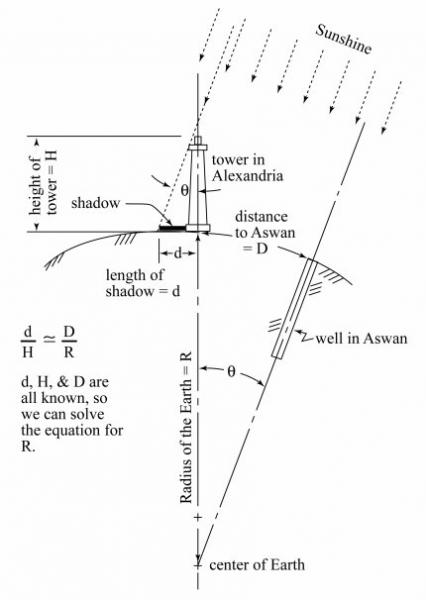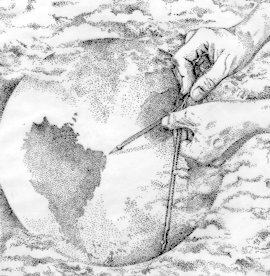Eratosthenes's Diameter of Earth
Today, we measure the earth. The University of Houston's College of Engineering presents this series about the machines that make our civilization run, and the people whose ingenuity created them.
The Discoverers, Daniel Boorstin's monumental book on human curiosity, tells about the complex task of figuring out the form of our planet. His chapter The Geography of the Imagination helps us understand how slowly Earth revealed itself to us.
Two complex ideas, the wheel and the globe, are grooved into our minds from infancy. It was only 5500 years ago that we finally saw how a rotating wheel could produce forward motion. Recognizing that Earth's apparently flat surface bends into the shape of a sphere was even more recent. Some cultures imagined Earth as a disc, some, box-shaped. The Egyptians said it was an egg, guarded at night by the moon. Only 2500 years ago, the Greeks finally decided Earth was a sphere. Plato argued that, since the sphere is a perfect shape, Earth must be spherical. Aristotle used observation. He pointed to the circular shadow Earth casts on the moon during an eclipse.
The poet John Donne looked back on all that difficulty a century after Magellan finally circumnavigated the Earth, and he wrote, "At the round earths imagined corners, blow Your trumpets, Angells."
The Greeks had no way of knowing how large the globe might be. The most daring travelers saw Earth reaching farther still beyond the fringe of their journeys. Then, in 200 BC, travelers told the head of the Alexandria Library, Eratosthenes, about a well near present-day Aswan. The bottom of the well was lit by the sun at noon during the summer solstice. At that moment the sun was straight overhead. Eratosthenes realized he could measure the shadow cast by a tower in Alexandria while no shadow was being cast in Aswan. Then, knowing the distance to Aswan, it'd be simple to calculate Earth's radius. (You geometry students, try that one.)
There was no accurate timekeeping back then. For Eratosthenes to make his observation, it had to be precisely noon in both cities. And he needed an accurate north-south distance from Alexandria to Aswan. Actually, Aswan lay south by southeast instead of due south, but the error wasn't great. His calculated size of Earth was high by only fifteen percent.
Three centuries later, the astronomer Ptolemy created many methods of modern geography. It was he who abandoned the idea that we're girdled by a great unsailable ocean. Ptolemy believed that other lands lay out in the terra incognita. He built upon Eratosthenes; but he also criticized him. When Ptolemy made his own estimate of size, he came out twenty-eight percent low.
Ptolemy's thinking suited Columbus, for it shrank Earth to fit his ships. He was plain dumb lucky that the West Indies intervened. And we need to remember what a mental leap the ancients had to make. The imagined four corners of the earth thwarted our understanding until a scant 2500 years ago. Only then did we finally fold our minds around the idea of a round earth. And it was only four hundred years ago that we actually managed the mind-numbing trick of traveling to the east by sailing west.
I'm John Lienhard, at the University of Houston, where we're interested in the way inventive minds work.
(Theme music)
Boorstin, D. J., The Discoverers: A History of Man's Search to Know His World and Himself. New York: Random House, 1983, Book Two: The Earth and the Seas, Part IV, The Geography of the Imagination.


lower image by Maria Zsygmond Baca, permission of Peter Gordon